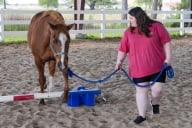You have /5 articles left.
Sign up for a free account or log in.

Latino student degree completion has stagnated. A new report from Excelencia in Education highlights successful programs and interventions to support Latino college student retention and graduation.
Hispanolistic/E+/Getty Images
Degree-completion rates among Latino students have stagnated in recent years while white students’ graduation rates have risen, according to a 2023 analysis from nonprofit group Excelencia in Education. This widening gap highlights a need for intentional supports for Latino learners to help them succeed.
Excelencia published a report in April highlighting five themes among evidence-based practices that promote Latino student success in college.
The five areas—preparing students and families for college, first-year experiences, bilingualism in academic and career connections, career pathways, and gender-based learning communities—take an asset-based approach to identify the strengths of Latino students and promote their achievement.
Based on Excelencia’s report, Inside Higher Ed compiled five common features for college leaders and practitioners looking to improve or create interventions geared toward Latino and Hispanic students.
- Involve families. Only 28 percent of Latino adults (age 25 and over) in the U.S. hold an associate degree or higher, meaning many of the students enrolled in higher education today are first-generation learners. Including parents and other loved ones in supporting their student in their educational journey is critical, and can be done through bilingual and culturally relevant education or coaching. The Latino Initiative at Utah Valley University hosts over a dozen parent open houses each year to involve prospective families, as one example. Gender-based programs can also include parents in college readiness initiatives, such as Arizona State University’s Hispanic Mother-Daughter Program.
- Create co-curricular spaces. Many colleges and universities provide workshops or events focused on Latino students or first-generation student success, which can promote belonging and connections among learners. California State University, Northridge, has a physical space on campus exclusive to its Bridge to the Future (B2F) scholars, who are Latino.
- Make resources bilingual. From enrollment to graduation, providing bilingual services is critical, whether that’s reaching out to high school students, engaging with families or providing tutoring and career counseling. Credit-based courses and programs can also help bridge equity gaps for students. Reading Area Community College in Pennsylvania offers an English for Academic Purposes Program that offers reading, writing, listening and speaking courses for bilingual Spanish English or non–native English speakers.
- Provide mentorship. Providing students with peer leaders or mentors who can guide them through college can increase students’ confidence and provide a safe place to seek help. The Personalized Achievement Contract Program at Mercy University pairs students with a professional mentor who helps with choosing a major, navigating requirements, registering for classes, financial literacy and more.
- Connect to community. Programs that help cultivate students’ passions through community engagement also see high levels of success. CSUN’s B2F participants commit to 20 hours of community service and the program establishes service projects based on their cultural history. California State University, Fullerton, helps counseling students serve Spanish-speaking communities through the Ánimo Latinx Counseling Emphasis, which infuses Latinx cultural values into the curriculum to provide specialized clinical training.
More of What Works
For practitioners looking for proven models of success, Excelencia maintains a database of active programs and initiatives that promote Latino student success across the country. The database can be filtered by academic level, issue area, state, program focus and whether the program takes place at a Hispanic-Serving Institution.
To be considered for the database, each program provides a profile that highlights mission, goals, history and practices, staff and budget, and evidence of effectiveness.
Seeking stories from campus leaders, faculty members and staff for our Student Success focus. Share here.



